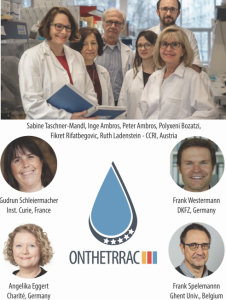
St. Anna CCRI research project ONTHETRRAC honored as “success story” by international research promotion network ERA-NET
The ONTHETRRAC research team discovered new aspects of tumor heterogeneity and developed tools that are important for accurate diagnosis, prognosis and for overcoming treatment resistance of the nerve tumor neuroblastoma in children. In the December newsletter 2021 its work was therefore honored as a “success story” by the research promotion network European Research Area (ERA-NET).
Neuroblastoma is one of the most common malignant cancers in young children and still poses a deadly threat to high-risk patients. What makes neuroblastoma such a complex disease to tackle, are the tumor’s heterogeneity, its resistance to treatment and recurrence. Overcoming these issues is at the heart of ONTHETRRAC’s efforts – a European research collective under the direction of Sabine Taschner-Mandl, PhD, Principal Investigator of the Tumor Biology Group at St. Anna Children’s Cancer Research Institute (St. Anna CCRI), and former CCRI scientists Univ.-Doz. Peter Ambros, PhD (em.) and Dr. Inge Ambros, MD (em.).
The ONTHETRRAC team has invested in cutting-edge technologies to gain new insight into the tumor heterogeneity of childhood neuroblastoma and relevance for the patient’s prognosis. Based on these novel insights the scientists developed new clinical diagnostic tools, such as minimally invasive liquid biopsy tests, as well as recommendations that have been implemented into the European high-risk neuroblastoma trial protocol.
Neuroblastoma is one of the most common malignant cancers in young children and still poses a deadly threat to high-risk patients. What makes neuroblastoma such a complex disease to tackle, are the tumor’s heterogeneity, its resistance to treatment and recurrence.  Overcoming these issues is at the heart of ONTHETRRAC’s efforts – a European research collective under the direction of Sabine Taschner-Mandl, PhD, Principal Investigator of the Tumor Biology Group at St. Anna Children’s Cancer Research Institute (St. Anna CCRI), and former CCRI scientists Univ.-Doz. Peter Ambros, PhD (em.) and Dr. Inge Ambros, MD (em.).
Overcoming these issues is at the heart of ONTHETRRAC’s efforts – a European research collective under the direction of Sabine Taschner-Mandl, PhD, Principal Investigator of the Tumor Biology Group at St. Anna Children’s Cancer Research Institute (St. Anna CCRI), and former CCRI scientists Univ.-Doz. Peter Ambros, PhD (em.) and Dr. Inge Ambros, MD (em.).
The ONTHETRRAC team has invested in cutting-edge technologies to gain new insight into the tumor heterogeneity of childhood neuroblastoma and relevance for the patient’s prognosis. Based on these novel insights the scientists developed new clinical diagnostic tools, such as minimally invasive liquid biopsy tests, as well as recommendations that have been implemented into the European high-risk neuroblastoma trial protocol.
Investigations revealed that liquid biopsy analyses can help detect more aggressive and treatment-resistant subclones of a tumor. This information is instrumental in discovering a potential relapse after treatment early on. The project funded by ERA-NET, the Austrian Science Fund (FWF), and other national funding agencies was a cooperation of experts in the fields of neuroblastoma, molecular genetics, and clinical research at St. Anna CCRI, Charité Berlin, Institut Curie Paris, the University of Ghent, and the German Cancer Research Institute in Heidelberg.